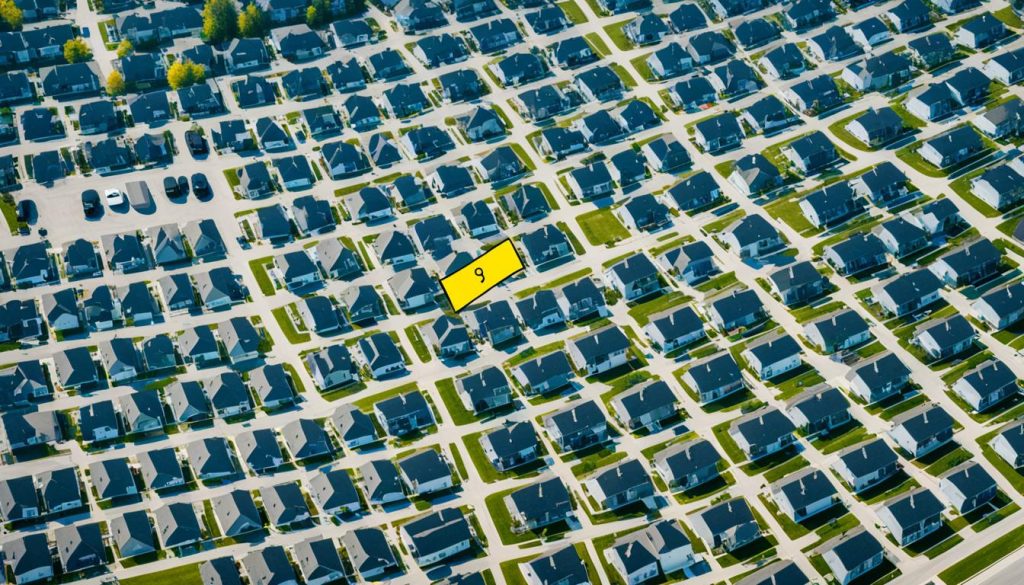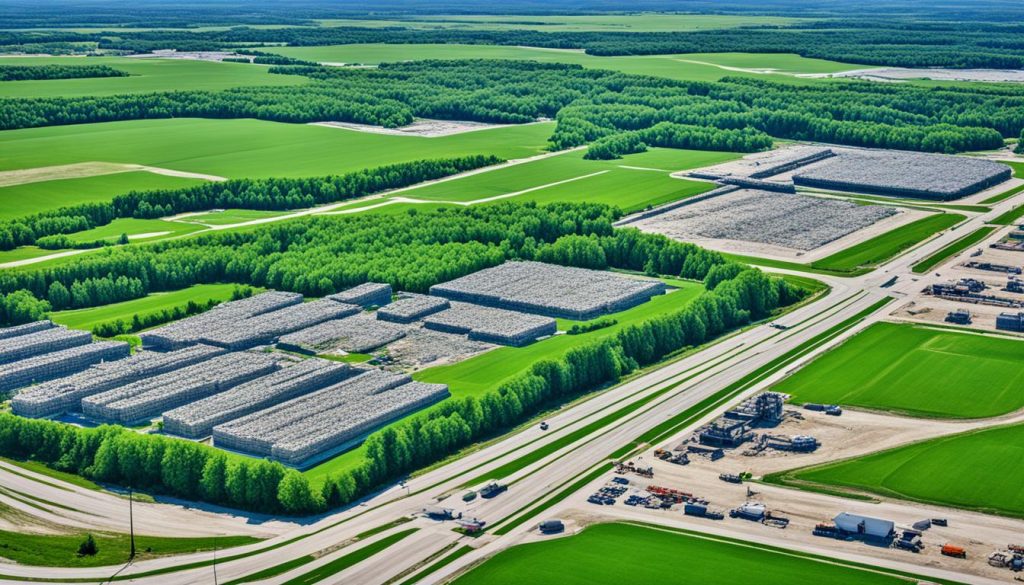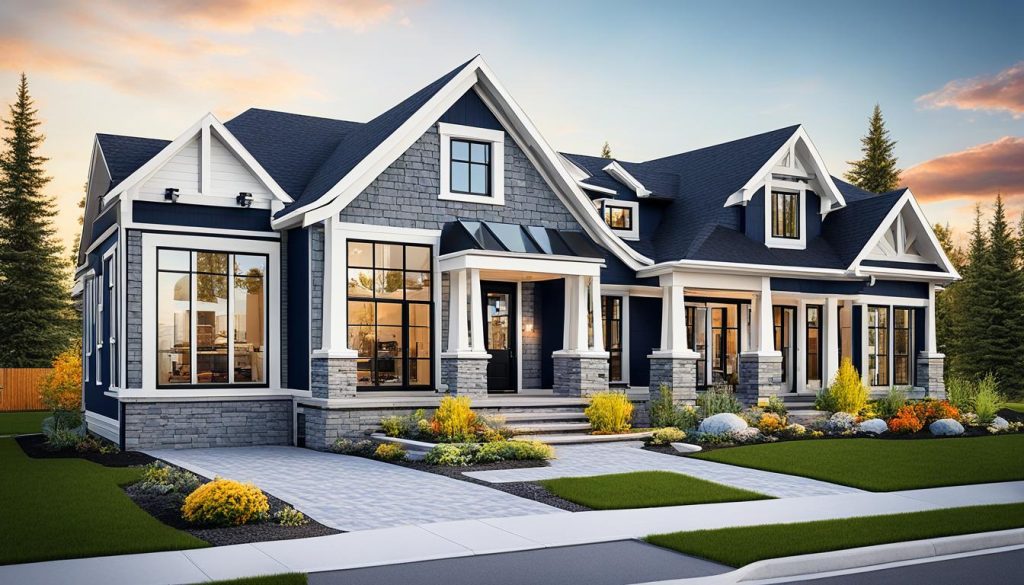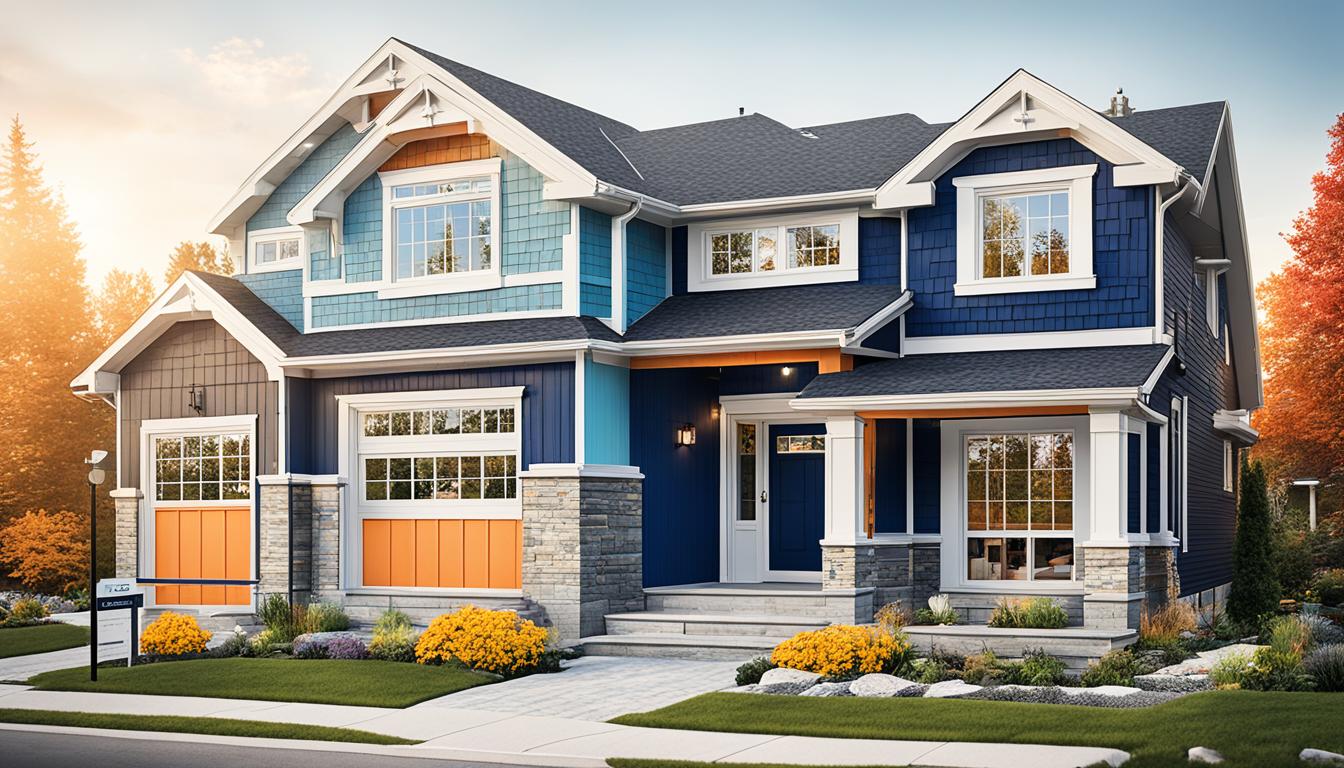Are you considering building your dream home in Ontario? If so, one of the first questions that may come to mind is, “How much does it cost to build a house in Ontario in 2024?” Residential construction costs in Ontario can vary greatly depending on numerous factors, such as the size of the house, the materials used, and the location of the property.
In addition to the actual construction expenses, building permit fees in Ontario also need to be taken into account. Understanding the average house construction cost in Ontario, along with the associated fees, is crucial for anyone embarking on a building project in the province.
In this article, we will delve into these details and provide you with a comprehensive overview of the costs involved in building a house in Ontario. Whether you’re a first-time homeowner or a seasoned developer, this information will help you plan and budget effectively for your upcoming project.
Introduction to Home Building Costs in Ontario
Embarking on a journey to build a custom home in Ontario combines the thrill of creating a personalized living space with a mosaic of financial considerations.
Understanding the cost of building a custom home in Ontario involves a comprehensive view of several factors, from the land acquisition in bustling cities like Toronto to the intricacies of material and labour expenses.
It’s essential to delve into why building may be a more viable option than buying and which key factors ultimately influence the financial output.

Should You Buy or Build Your Next House?
The decision to buy or build a house is a significant one, with each option offering its own set of advantages and challenges. Here’s a breakdown to help you make an informed choice.
1. Evaluating Your Needs
Start by assessing your space requirements and long-term goals. Building allows for complete customization to meet your needs while buying offers the convenience of a move-in-ready home. Consider how future-proof your choice will be in terms of family expansion or changing needs.
2. Cost Comparison
Comparing the initial investment is crucial. Building a house typically requires a higher upfront cost, but it can be more cost-effective in the long run, especially if you factor in energy efficiency and reduced maintenance. Buying a house may involve lower initial costs, but you might spend more on renovations or modifications.
3. Location Considerations
Availability of land can be a limiting factor when building. If you have a specific area in mind, it may be easier to find an existing home rather than land to build on. Additionally, established neighborhoods offer amenities and a sense of community that new developments may lack.
4. Time and Effort Involved
Building a home is a time-consuming process that requires a significant amount of effort, from managing the build to making countless decisions. Buying, on the other hand, offers a quicker path to homeownership, often with less stress and involvement.
5. Customization vs. Compromise
Building allows you to design your home exactly as you want it, with every detail tailored to your preferences. Buying might mean compromising some aspects of the home, such as layout or finishes, but it also means immediate availability and less hassle.
6. Market Trends and Future Value
Understanding the current real estate market is key. Building in an up-and-coming area can increase the future value of your home while buying in a stable market can offer reliable long-term investment. Consider how market fluctuations could affect your decision.
7. Emotional and Lifestyle Factors
The emotional satisfaction of creating a home from scratch can be a powerful motivator to build. However, the appeal of moving into an established home with mature landscaping, a developed neighborhood, and immediate availability is equally compelling. Consider how each option aligns with your lifestyle and emotional needs.
Why Consider Building Over Buying?
Building a custom home allows you to tailor every detail to your preferences, providing a level of personalization that existing properties cannot match. When contemplating a custom home, it’s crucial to factor in the cost to build a custom home in Ontario, which can be higher compared to purchasing an existing house.
However, this cost is often balanced by the value of having a home that perfectly suits your needs and desires. While market conditions and regulatory landscapes play roles, the autonomy in design and construction choices often justifies these initial expenditures.
Key Factors Influencing Building Costs
Several elements contribute to the building a house cost in Ontario. Key influencers include:
- Land Acquisition: Urban locales like Toronto and Mississauga represent substantial cost variations.
- Construction Materials: Price differentials for flooring, roofing, and windows can vary by up to 180%.
- Labor Expenses: Skilled labor costs in Ontario typically add 20-25% to the overall project expenses.
- Design Complexity: Custom homes with full basements range between $180 to $220 per square foot, while slab foundation homes cost $150 to $180 per square foot.
- Regulatory Requirements: Permits, inspections, and other compliance-related spendings can represent 5-10% of the total construction budget.
- Market Conditions: Economic scenarios influencing material prices and labor availability can lead to cost variations of 10-15%.
- Government Fees: Government charges and fees add nearly $200,000 to the overall cost of building a home in Ontario.
Let’s examine a cost breakdown for better clarity:
| Cost Component | Cost Range | Remarks |
|---|---|---|
| Land Acquisition | Variable | Higher in urban areas like Toronto |
| Construction Materials | $150 – $220 per sq. ft. | Depends on material quality |
| Labor Expenses | 20-25% of total cost | Impact of skilled labor |
| Regulatory Requirements | 5-10% of total cost | Includes permits and inspections |
| Government Fees | Nearly $200,000 | Additional to the building costs |
By understanding these fundamental components, prospective homeowners can gain a clear perspective on the new home construction expenses Ontario, paving the way for informed financial planning and successful project execution.
How Long Does It Take to Build a New Home?
Building a new home is an exciting journey, but it’s important to have realistic expectations about the timeline. Several phases determine how long the process will take.
1. Pre-Construction Phase
The initial phase involves planning, securing permits, and obtaining financing. This can take several weeks to months, depending on the complexity of your project and local regulations. Choosing a builder and finalizing contracts are also part of this phase, setting the stage for the build.
2. Site Preparation
Once you have the necessary permits, the site needs to be prepared. This includes clearing the land, grading, and installing utilities like water and electricity. The foundation work follows, which typically takes a few weeks but can vary depending on weather conditions and the type of foundation.
3. Structural Work
The framing stage, where the skeleton of your home is built, usually takes several weeks. Once the frame is up, the roof, windows, and doors are installed. This stage can be affected by weather, as extreme conditions can cause delays.
4. Interior Work
With the exterior sealed, work begins on the interior. This includes installing electrical wiring, plumbing, and HVAC systems. Once these are in place, insulation and drywall are added, followed by flooring and other interior finishes. Each of these steps can take several weeks, depending on the complexity of the design.
5. Final Inspections and Approvals
Before moving in, your home must pass various inspections to ensure it meets all building codes and regulations. Scheduling these inspections can cause delays if inspectors are busy. After the final walkthrough, you can address any issues and prepare for move-in.
6. Post-Construction Phase
Even after construction is complete, there may be minor adjustments or warranty work needed. Moving in can be a gradual process, and it’s wise to allow some time for any final touches or corrections. This phase ensures that your home is truly ready for you to settle in.
How Much Does it Cost to Build a House in Ontario?
Understanding the financial aspect of building a house is crucial for any prospective homeowner. To answer the question, how much does it cost to build a house in Ontario, it’s important to consider various elements. The average construction cost stands at $320 per square foot, but this figure is influenced by an array of factors including location, house size, and the complexity of the build.
Custom architectural designs add another layer of expense, averaging about 25% more than pre-designed plans. This variation highlights the impact of design choices on residential construction costs Ontario residents need to consider. Labor costs have also seen an increase, with average wages rising by 4.2% to $32.94 per hour as of 2022.

Additional soft costs, which can range from $20-$50 per square foot, must be accounted for as well. These can include expenses related to water and sewer hookups, which in urban areas of Ontario can be around $15,000, whereas a septic system in more remote areas might cost upwards of $25,000.
Here is a breakdown of the typical costs involved:
| Location | Average Cost per Square Foot |
|---|---|
| Toronto | $1,013 |
| Northern Ontario | $411 |
Local building permits and the lay of the property can also affect costs significantly. Building and development expenses in Ontario range from $10,000 to $30,000, translating to an average difference of $11.00 per square foot for an 1,800 square foot home.
Moreover, the style and shape simplicity of the home play a significant role; two-storey homes, for example, are generally the most cost-effective due to their smaller foundation and more compact design.
Various factors, from labor costs to geographical location, contribute to the overall expenditure. By considering these elements, one can better gauge residential construction costs Ontario and make informed decisions tailored to their budget and needs.
Land Acquisition Costs
Land acquisition constitutes one of the most significant cost factors when building a house in Ontario. The *land acquisition costs Ontario* vary greatly, influenced by whether the land is urban or rural and location-specific factors.
1. Cost Variations by Location
The cost of land in Ontario can vary dramatically based on its geographical location. In urban settings like downtown Toronto, a standard lot may approach or exceed $1 million. However, prices drop significantly in suburban or rural areas. For example, the average price per square foot in Toronto was $1013 as of 2022, whereas in Northern Ontario, it could be as low as $411.

Whether you’re eyeing a piece of land for new construction or a lot destined for demolition, urban plots carry a substantial price tag. In contrast, purchasing land in less developed areas can yield considerable savings, especially for those who acquire these lands early.
2. Urban vs. Rural Land Prices
Understanding the difference between urban and rural land prices is crucial for planning your budget. Here’s a comparative look at the land acquisition costs in Ontario:
| Location | Average Price per Square Foot (2022) | Additional Considerations |
|---|---|---|
| Toronto (Urban) | $1013 | High demand, proximity to amenities |
| Oakville (Suburban) | $800 | Suburban luxury, good schools |
| Northern Ontario (Rural) | $411 | Lower cost, longer commutes |
| Southern Ontario (Mixed) | $150-$300 | Balanced options between urban and rural |
Land acquisition costs Ontario can vary not only in price per square foot but also in other expenses such as *building permit fees Ontario*. The choice between urban, suburban, and rural areas can significantly impact the financial planning of your home building project. By understanding these variations, you can better navigate the complex landscape of land acquisition and planning in Ontario.
Design and Architectural Planning
When embarking on a home-building project in Ontario, careful consideration of design and architectural planning is essential. The choices between custom and pre-designed plans can significantly influence the overall budget and complexity of the project. Custom home prices in Ontario often reflect the level of personalization and intricacy involved in the design process.

1. Choosing Between Custom and Pre-Designed Plans
Opting for custom home designs offers the advantage of tailoring every detail to your preferences and needs. These designs are drawn up by architects who translate your vision into blueprints, ensuring a unique aesthetic and functional fit.
On the other hand, pre-designed plans are generally more budget-friendly and quicker to implement, although they lack the personalized touch of custom homes. The decision between the two pivots on factors like budget constraints, desired customization, and project timelines.
2. Costs Involved in Hiring Architects and Designers
Engaging professional architects can range between $6 to $15 per square foot, a reflection of the experience and expertise they bring to the table. These fees encapsulate the design and architectural planning Ontario homeowners can expect, covering everything from initial sketches to detailed construction drawings.
Furthermore, personalized features such as bespoke architectural details can notably increase the overall budget. The upfront costs associated with hiring seasoned architects can ultimately lead to savings by mitigating design flaws and ensuring more efficient construction processes.
Balancing aesthetics and financial considerations is crucial; high-quality custom designs can significantly elevate the final appearance and functionality of the home while adhering to budgetary constraints. Considering both design expertise and cost-effectiveness will help achieve the desired outcome without compromising on either aspect.
Labor Costs and Contractor Fees
Understanding labor costs and contractor fees is crucial when planning to build a house in Ontario. These costs represent a significant portion of the overall construction budget and can vary based on several factors such as complexity of the project and the skill level of the workers.
1. Average Labor Costs in Ontario
Labor costs in Ontario generally reflect the region’s economic climate and the specialized skills required. As of 2022, the average hourly wage for construction labor was around $32.94. This variability in labor costs Ontario can impact your overall budget, especially for larger or more complex projects that require specialized trades.
2. Benefits of Hiring General Contractors
Engaging a general contractor can significantly streamline the building process. General contractor fees Ontario typically range from 10% to 20% of the total project cost, depending on the scope and complexity of the build. Despite this added expense, the expertise and coordination provided by general contractors can result in smoother project execution and potential cost savings in the long run.
Labor and general contractor fees Ontario are essential considerations when budgeting for your new home construction. By understanding these costs and investing in experienced professionals, you can ensure a higher level of efficiency and quality in your building project.
Material Costs and Availability
Understanding material costs in Ontario and the availability of construction materials Ontario is crucial for budgeting and planning a home construction project. The fluctuation in prices and the supply chain dynamics of various materials directly impact overall building expenses. Homeowners need to be aware of these aspects to manage their construction projects efficiently.
1. Common Materials Used in Home Construction
Key materials commonly used in home construction include lumber, concrete, and steel. These primary materials form the backbone of most residential buildings. Lumber, often used for framing, has seen significant price volatility over recent years due to global supply chain issues. Concrete and steel, essential for foundations and structural support, also vary in cost depending on market conditions.
2. Market Fluctuations Impacting Prices
Several factors can cause material cost fluctuations, including global economic health, supply chain stability, and local demand dynamics. In Ontario, the demand for construction materials has been heightened by rapid population growth and a booming housing market.
For instance, according to the Altus Group’s 2023 Canadian Cost Guide, the cost per square foot for detached homes in Toronto ranges from $250 to $300. Comparatively, Ottawa’s construction costs fall between $235 and $375 per square foot.
These price ranges reflect not just base material costs but also factors like supply chain disruptions and increased demand in urban areas. Builders and homeowners must consider the availability of construction materials Ontario when planning their projects.
Choosing alternative materials and finishes can help mitigate some costs. Additionally, smart sourcing and bulk purchases during periods of price stability can provide financial relief.
| City | Price per sq. ft. |
|---|---|
| Vancouver | $200 to $350 |
| Calgary | $190 to $300 |
| Toronto | $250 to $300 |
| Ottawa | $235 to $375 |
In summary, navigating the complexities of material costs Ontario and ensuring the availability of construction materials Ontario are essential for effective project management. By understanding market trends and making informed material selections, homeowners can better control their building costs.
Building Permit Fees and Regulatory Compliance
Navigating the labyrinth of building permits and local regulations adds another layer to the construction budget, with Ontario’s new home building permits ranging between $6,000 and $15,000. This expenditure is non-negotiable, contributing to a safe and legally sound residence.
1. Cost of Building Permits in Ontario
Building permit costs in Ontario vary by municipality and project scope. Residential building permit fees in areas like Mississauga start at around $174. Residential building permit applications in some cities may take around ten working days for review. Important factors include:
- Construction should commence within six months of permit issuance to avoid revocation.
- If construction halts for over a year, the permit may be revoked.
- Accurate and detailed drawings are essential for new house building permit applications.
- Key drawings required include site plans, floor plans, elevation drawings, and structural framing drawings.
2. Ensuring Compliance with Local Regulations
Ensuring compliance with local regulations is critical to avoid significant fines, which can reach up to $50,000. Non-compliance with building permits includes failing to obtain permits and not adhering to inspections. Regulatory compliance costs in Ontario could involve environmental assessments and mandatory inspections:
- Working with professionals like Elmid Design Inc. can simplify the permit process.
- The Ontario Building Code requires municipal reviews within a specific timeframe: 10 days for houses, 30 days for more complex buildings like hospitals.
- Penalties for building without a permit: up to $50,000 for a first offense and up to $100,000 for subsequent offenses.
- Corporations face fines up to $500,000 for first offenses and $1,500,000 for subsequent infractions.
| Permit Type | Cost |
|---|---|
| Residential Units | $52.08 per unit |
| Single-Family Dwellings | $17.16 |
| Demolition Fees | $0.16 per sq.ft. |
| Alterations and Renovations | $4.93 to $5.73 per sq.ft. |
| HVAC and Plumbing | $198.59 to $428.95 |
Overall, building permit fees and regulatory compliance costs in Ontario are important considerations for anyone looking to construct a new home or undertake significant renovations. These fees ensure construction projects meet safety, environmental, and community standards, promoting long-term value and harmony in Ontario’s residential landscape.
Utilities and Infrastructure Costs
When building a new home in Ontario, understanding the utilities and infrastructure costs Ontario is crucial. Establishing new home utility connections for water, sewage, electricity, and internet involves varying expenditures that hinge significantly on the development level of the area.
In urban settings, integrating into the existing city’s infrastructure could cost around $15,000. Conversely, remote and less developed locales may necessitate additional expenses such as installing a septic system, which can exceed $25,000. This stark contrast underscores the role geography plays in the financial landscape of home building.
Municipal governments in Ontario rely heavily on development charge revenue, having collected approximately $2.3 billion from such charges in 2017 alone. These charges can add as much as $90,000 to the new home construction costs, especially in parts of the Greater Toronto Area. Development charges are reported to cover only about 80% of associated capital costs, placing additional financial burdens on homeowners and local tax bases.
The Association of Municipalities Ontario reports that development charges represent about 5% to 7% of a new single-family home’s cost, while the Canada Mortgage and Housing Corporation (CMHC) found 2022 charges in Toronto ranged from 2% to 13% of home costs. Total government charges, including various fees, can amount to over 20% of construction costs in major Canadian cities.
Affordable housing units and other specific residential categories are exempt from development charges, softening the financial impact on certain homeowners. However, municipalities face significant barriers to financing necessary projects, including an aversion to incurring debt and shifting capital costs through property taxes.
| Aspect | Development Charges |
|---|---|
| Collected Revenue (2017) | $2.3 billion |
| Cost Addition to New Home | Up to $90,000 |
| Coverage of Capital Costs (Milton Study) | Approximately 80% |
| Charges as Percentage of Home Cost (Toronto) | 2% to 13% |
| Total Government Charges Impact | Over 20% of construction costs |
The burden and variability of new home utility connections Ontario, alongside other infrastructure-related costs, reveal the multifaceted challenges in the home-building process. Balancing these with effective financial strategies is crucial for sustaining growth in the province’s housing sector.
How to Save Money When Building a House?
Building a house is a significant financial investment, and saving money without compromising quality is a priority for many. Here’s how you can make smart financial decisions during the construction process:
1. Planning and Budgeting
Before breaking ground, create a detailed plan that includes every aspect of the build, from design to final finishes. Set a realistic budget that factors in all potential costs, including permits, materials, labor, and unexpected expenses. Prioritize your needs over wants, focusing on the essentials first.
2. Choosing the Right Location
The location of your build can significantly impact your budget. Some regions have higher land costs, while others offer more affordable options. Consider the long-term value of the location and how it aligns with your lifestyle needs. Balancing convenience, such as proximity to work or schools, with cost can lead to substantial savings.
3. Design Considerations
Opt for a simple, straightforward design. Complex designs with unique shapes or features often require more materials and labor, driving up costs. Incorporate energy-efficient elements that may have a higher upfront cost but save money in the long run. Avoid unnecessary features that don’t add value to your home.
4. Selecting Materials
Choose cost-effective materials that are durable and long-lasting. While high-end materials can be appealing, there are often more affordable alternatives that offer similar benefits. Sourcing materials locally can also reduce costs associated with transportation and support your local economy.
5. Hiring Professionals
Selecting the right contractor is crucial. Take the time to get multiple quotes, check references, and ensure they have a good track record. Negotiate labor costs where possible, and consider managing some tasks yourself to cut costs. However, ensure that any DIY work is within your skill level to avoid costly mistakes.
6. Managing the Build
Sticking to the timeline is essential to avoid additional costs. Regularly review the progress of the build and maintain open communication with your contractor to address any issues promptly. Delays can lead to increased labor costs and extended financing charges, so proactive management is key.
7. Final Touches
When it comes to finishes, look for cost-effective options that still offer a quality look and feel. Landscaping can be done on a budget by opting for simple, low-maintenance plants and designs. Plan for future upgrades, allowing you to spread out costs over time rather than all upfront.
Conclusion
Embarking on the journey to build a custom home in Ontario presents a blend of complexities and rewarding opportunities. From the initial phase of land acquisition, where urban areas command higher prices compared to their rural counterparts, to the application of high-ratio mortgages widely favoured among home builders, each step demands thoughtful planning and financial prudence.
The new house build cost in Ontario varies significantly based on location, design, material choices, and labor costs, underscoring the necessity for a well-calibrated budget and clear contracts with contractors.
Implementing strategies like incorporating energy-efficient designs and sustainable materials such as bamboo flooring and recycled glass countertops not only contribute to long-term cost savings but also enhance the home’s resale value.
Furthermore, adopting cost-saving measures, including the use of reclaimed materials and requesting quotes from multiple builders, can help keep expenses within reasonable bounds without sacrificing quality. Provisioning a contingency fund is also crucial to mitigate unexpected expenses during the construction phase.
Engaging with financial institutions for high ratio mortgages, such as those offered by Everything Mortgages, and leveraging streamlined online application processes, can simplify financial management during this intricate process.
The effort invested in customizing a home to meet personal expectations, coupled with the potential investment returns, makes building a custom home in Ontario a fulfilling endeavor.
With meticulous planning, clarity in contracts, and open communication with your construction team, your dream home can become a reality within the varied landscape and regulations of Ontario.
FAQ
How much does it cost to build a house in Ontario in 2024?
The average house construction cost in Ontario is around $320 per square foot. This figure can vary based on factors like location, house size, and complexity. For a custom home in urban areas like Toronto, the cost can range from $205 to $280 per square foot, excluding land costs.
Why should I consider building over buying a resale property?
Building a custom home allows you to tailor the design and specifications to your personal preferences, enabling better energy efficiency and modern amenities. Financially, new homes often carry fewer maintenance costs initially and can be built to higher standards than older properties. However, it’s essential to consider the comprehensive budget for construction, including land acquisition, which can sometimes exceed the cost of a resale home.
What are the key factors influencing building costs?
The major factors include land purchase, construction materials, labor, design complexity, and adherence to regulatory standards. Location plays a significant role in land costs, with urban centers like Toronto demanding substantially higher prices for plots. Additionally, material choices and labor expenses reflect market conditions and can significantly impact the overall budget.
How do land acquisition costs vary by location?
In urban centers like Toronto, land can cost upward of $1 million per plot. In contrast, rural areas offer considerably more affordable options. The disparity is vast; hence, the location of your future home greatly affects your total investment.
What are the costs involved in choosing custom vs. pre-designed plans?
Custom plans provide personalized aesthetics and typically cost between $6 and $15 per square foot when employing experienced architects. Pre-designed plans can be more cost-effective but may not meet specific needs or site conditions as precisely as custom designs.




